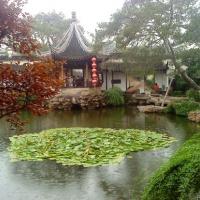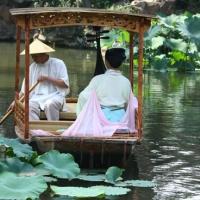With an area of three hectares, The Lingering Garden (Liu Yuan) is one of the largest Suzhou gardens, noted for its adroit partitioning with building complexes. It dates to the Ming Dynasty and managed to escape destruction in the Taiping Rebellion. The garden's name which means the garden for lingering in, was originally the residence of a Ming official Xu Shitai, and named East Garden.
The garden comprises of four sections; its middle section was originally named "Hanbi Mountain Villa", and is the garden's quintessential part. The layout of this section is emphasized on mountains and ponds. It is surrounded by mountains, rocks, buildings and pavilions, and had many long corridors and bridges interlinking its landscape.
The eastern section has many magnificent and spacious halls, pavilions, corridors, and large and small rockeries. The western section is emphasized on large rockeries, and it has mountains clad with maple trees. The northern section has a view of natural mountain villages, using a bamboo picked fence enclosing a small garden of miniature trees of many famous species.



A 700 meter covered walkway connects the major scenic spots, and windows select perspectives carefully for you. The walkway is inlaid with calligraphy from celebrated masters in the Jin, Tang, Song, Yuan, Ming, and Qing Dynasties, these invaluable steles of Chinese calligraphy in the past 1,000 years are valuable heritages in China. The garden has a wealth of potted plants. Outside Mandarin Duck (Yuanyang) Hall is a 6.5 meter high Lake Tai piece, the final word on rockeries.
Suzhou Lingering Garden is one of the four most famous Gardens in China. It was listed into the World Heritage Sites in 1997.
Want to see more Suzhou gardens? See Top Ten famous Suzhou Gardens
